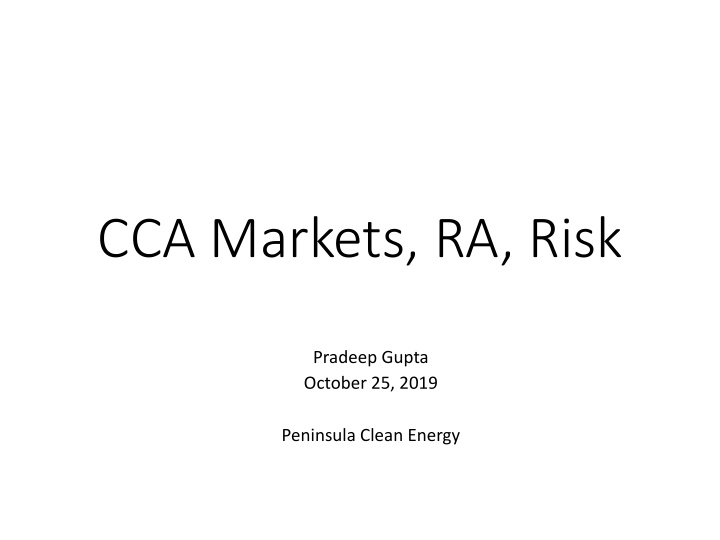



CCA Markets, RA, Risk Pradeep Gupta October 25, 2019 Peninsula Clean Energy
Current C Concerns Wildfire Utility Issues • System Reliability/Resource Adequacy • Distributed Energy Resources (DER) • A Review of Markets, Reliability and Risk • Management 2
Power I Industry • Why grid? •Long distance between utility plants and cities •Line loss lesser for high voltage- so grid. •Loss of grid lines lead to blackouts • MICROGRID OPTION 3
Western E Electricity C y Coordinating C Council ( (WECC) § Western Interconnection • Multiple BAAs § Balancing Authority Area (BAA) • Maintain Supply/Demand Balance - Demand = Supply + Imported Energy • Manage Inter-Tie Tagging • Manage System Frequency • Manage Coordinated Dispatch of Generation 4
8 C California B Balancing A Auth thority ty A Areas § CAISO BAA • 45,000 MW • 26,000 circuit miles • Wholesale Power Market • Reliable Operations • Grid Planning 6
6
En Energ rgy § Transacting Energy • Bilateral Wholesale Markets • CAISO Day-Ahead Market • CAISO Real-Time Market § Physical / Financial Transactions § Inter-SC Transactions 7
Energy M y Market P Price V Volatility § Key Drivers of Energy Market Prices • Natural Gas - Storage - Transport - Demand • Weather - Local and Regional • Hydrology • Policy and Changing Supply Composition - RPS - GHG Free Objectives 8
9
10
11
Hyd ydrology F y Forecast 12
Integration o of R Renewables 13
Impact o of S Solar / / W Wind o on E Energy P y Prices 14
16
Energy R y Risk M Management § Risk Management Objectives • Mitigate Exposure to Volatility • Durable Rates • Financial Stability • Regulatory Compliance § Key Energy Market Risks • Volumetric Risk - Fluctuations in the volume of supply and demand • Price Risk - Price volatility 17
18
Long T Term t to S Short T Term H Hedge S Strategy § Long Term Hedging • Load Forecasting • Coverage Objectives • Market Conditions • Resource Composition § Short Term Hedging • Refined Load Forecast • Intra-Month / Intra-Day Shaping • Market Conditions § Fixed Price Energy Hedging • Inter-SC Trades 19
Example o of H Hedging T Tools § Inter-SC Trade of Energy • Tool used to fix the costs of energy supply - All Hours (7 X 24) - On-Peak Delivery (HE 07 to HE 22) - Off-Peak Delivery (HE 01 to HE 06 & HE23/24) - Shaped DeliveryImports / Exports § Options § Generation Resource 21
Forward E Energy C y Curve NP15 On-Peak Forward Power - EOX $70 $60 $50 $40 $30 FY 2019 Budget $20 FY 2020 BUDGET 6/22/2015 1/8/2016 9/24/2018 $10 11/5/2018 11/26/2018 2/11/2019 2/15/2019 $0 Mar-19 Jun-19 Sep-19 Dec-19 Mar-20 Jun-20 Sep-20 Dec-20 Mar-21 Jun-21 Sep-21 Dec-21 Mar-22 Jun-22 Sep-22 Dec-22 22
§ MWh Coverage and Value-at-Risk Hedging • Match Demand with Fixed Price Supply - Reduces exposure to market price volatility - Form of Insurance § May include premium cost similar to insurance • Establish Coverage within Risk Tolerance - Maintain open position based on value-at-risk - Value-at-risk is a measure of risk of loss 23
Resource Adequacy
Current W Wholesale M Markets D Designs § Clear supply and demand at the marginal cost of supply, while maintaining the reliability of the system. § Current wholesale market designs have been challenged in providing adequate financial incentives to support efficient entry. § This in turn has led to the development of “resource adequacy,” pricing mechanism.
RA P Program § Resource Adequacy Requirements • Load Serving Entities (LSE) must demonstrate they have purchased a defined amount of capacity § System Resource Adequacy • 115% of LSE monthly peak-demand • Supplied from qualified resources Net Qualified Capacity - § Local Resource Adequacy • Capacity located in specific geographic locations • Sub-requirement (% of overall capacity must be local) § Flexible Resource Adequacy • Capacity with defined operational characteristics • Sub-requirement (% of overall capacity with ramping) 26
28
Tightening RA Markets • RA prices doubled between 2018 and 2019. • Only 463 MW of new resources came online since 2018 significantly less than the capacity retired during that period. • Nearly 2,000 MW of solar and wind capacity will be lost due to declining ELCC values and several thousand MW of once-through-cooling generators are slated to retire.
RA RA Value of of Renewable Resou ources • Historically based on “exceedance” approach: • The minimum amount of generation produced by the resource in a 70% of included hours. • Now- Effective Load Carrying Capability (ELCC %) and Qualifying Capacity (QC) of wind and solar resources. • ELCC- derating factor applied to maximum output (Pmax) to determine its QC.
CalCCA Proposal • Prescribe the volume of RA each IOU must make available to the market • Require the IOUs to offer excess RA products for up to a three-year term • Develop guidance on the use of price floors in IOU requests for offers to ensure the IOUs maximize the volume of RA that can be sold.
Central Procurement Entity (RA-CPE) • Meet Residual of a three-year forward procurement obligation that is not met by individual LSEs. • RA-CPE will be a competitively neutral, independent, and creditworthy entity • Who will be RA-CPE? •
Recommend
More recommend